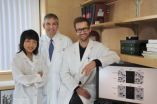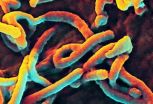(Press-News.org) Researchers from the RIKEN Brain Science Institute in Japan, in collaboration with Juntendo University and the Japan Science and Technology Agency, have discovered that a cell receptor widely involved in intracellular calcium signaling--the IP3R receptor--can be locked into a closed state by enzyme action, and that this locking may potentially play a role in the reduction of neuron signaling seen in neurodegenerative diseases such as Huntington's and Alzheimer's disease.
In the research published today in the Proceedings of the National Academy of Sciences, the scientists reported experiments in human cells and a mouse model of Huntington's disease revealing that transglutaminase type 2--a protein cross-linking enzyme elevated in the cells of patients with neurodegenerative diseases--interacts with the IP3R receptor to lock it in a closed non-functional conformation preventing it from fulfilling its essential calcium-releasing role. They identified a specific amino acid site on the receptor, Gln2746, where the modification takes place, deepening our understanding of how receptors are locked and potentially opening the door to studies on other functional proteins that are also regulated by conformational changes.
The IP3R channel, which is located in the endoplasmic reticulum, a protein assembly and transport compartment, plays a crucial role in intracellular calcium signaling, and is involved in a wide range of cell functions including mitochondrial energy production and the regulation of autophagy, the process through which cells consume and degrade unused components to maintain a healthy balance of functional proteins. Although autophagy is normally a mechanism that sustains cell maintenance, it can also trigger a loss of cell function and has been associated with prominent diseases including Huntington's disease, Alzheimer's disease, and Parkinson's disease.
In this work, the scientists propose a general model under which abnormal IP3R-mediated calcium signaling caused by the action of transglutamase type 2 leads to cellular dysfunction and subsequently to the emergence of progressive brain dysfunction. Transglutaminase 2 activation is commonly associated with inflammation and stress, and its action on the IP3R channel might provide an explanation for the initiation and progression steps common to different neurodegenerative diseases.
According to Katsuhiko Mikoshiba, who led the study, "We think that the mechanism we identified in this study could provide us with a more general model of other diseases both of the brain and other parts of the body, where transglutaminase type 2 is upregulated. We hope that this insight could eventually lead to the development of new drug therapies for a number of neurodegenerative diseases that place a high burden on patients and society."
INFORMATION: END
Broken signals lead to neurodegeneration
2014-09-08
ELSE PRESS RELEASES FROM THIS DATE:
In directing stem cells, study shows context matters
2014-09-08
MADISON, Wis. — Figuring out how blank slate stem cells decide which kind of cell they want to be when they grow up — a muscle cell, a bone cell, a neuron — has been no small task for science.
Human pluripotent stem cells, the undifferentiated cells that have the potential to become any of the 220 types of cells in the body, are influenced in the lab dish by the cocktail of chemical factors and proteins upon which they are grown and nurtured. Depending on the combination of factors used in a culture, the cells can be coaxed to become specific types of cells.
Now, in ...
Co-flowing liquids can stabilize chaotic 'whipping' in microfluidic jets
2014-09-08
VIDEO:
This video show jets emerging from the same glass needle in chaotic whipping (left) and a steady state helical whipping. By controlling the viscosity and speed of the liquid surrounding...
Click here for more information.
Industrial wet spinning processes produce fibers from polymers and other materials by using tiny needles to eject continuous jets of liquid precursors. The electrically charged liquids ejected from the needles normally exhibit a chaotic "whipping" structure ...
Brain injuries no match for sPIF treatment
2014-09-08
New Haven, Conn. — Researchers at Yale School of Medicine and their colleagues have uncovered a new pathway to help treat perinatal brain injuries. This research could also lead to treatments for traumatic brain injuries and neurodegenerative disorders such as Alzheimer’s and Parkinson’s.
The findings are published in the Sept. 8 issue of Proceedings of the National Academy of Sciences.
The microRNA let-7 is known to cause the death of neurons in the central nervous system. The research team found that a synthetic molecule derived from the embryo called PreImplantation ...
Textbook theory behind volcanoes may be wrong
2014-09-08
In the typical textbook picture, volcanoes, such as those that are forming the Hawaiian islands, erupt when magma gushes out as narrow jets from deep inside Earth. But that picture is wrong, according to a new study from researchers at Caltech and the University of Miami in Florida.
New seismology data are now confirming that such narrow jets don't actually exist, says Don Anderson, the Eleanor and John R. McMillian Professor of Geophysics, Emeritus, at Caltech. In fact, he adds, basic physics doesn't support the presence of these jets, called mantle plumes, and the ...
UCLA biologists delay the aging process by 'remote control'
2014-09-08
UCLA biologists have identified a gene that can slow the aging process throughout the entire body when activated remotely in key organ systems.
Working with fruit flies, the life scientists activated a gene called AMPK that is a key energy sensor in cells; it gets activated when cellular energy levels are low.
Increasing the amount of AMPK in fruit flies' intestines increased their lifespans by about 30 percent — to roughly eight weeks from the typical six — and the flies stayed healthier longer as well.
The research, published Sept. 4 in the open-source journal Cell ...
Rapid and durable protection against ebola virus with new vaccine regimens
2014-09-08
One shot of an experimental vaccine made from two Ebola virus gene segments incorporated into a chimpanzee cold virus vector (called chimp adenovirus type 3 or ChAd3) protected all four macaque monkeys exposed to high levels of Ebola virus 5 weeks after inoculation, report National Institutes of Health (NIH) scientists and their collaborators. The ability of the ChAd3 Ebola virus vaccine to elicit rapid protection in monkeys is notable as the world health community battles an ongoing Ebola virus disease outbreak in West Africa. While the protective effects of the single ...
Teens living with 2 college-educated parents less likely to use alcohol and marijuana
2014-09-08
ARLINGTON, Texas -- A high school senior who lives with two college-educated parents is significantly less likely to drink alcohol or smoke marijuana than a teenager who lives with one parent, a new University of Texas at Arlington study has found.
For example, teens living with their mother only are 54 percent more likely to use alcohol, and 58 percent more likely to smoke if they live only with their father.
Eusebius Small, an assistant professor in the UT Arlington School of Social Work, analyzed data on 14,268 teenagers to determine the impact of family structure ...
Ohio University paleontologists discover new species of titanosaurian dinosaur in Tanzania
2014-09-08
ATHENS, Ohio (Sept. 8, 2014)—Ohio University paleontologists have identified a new species of titanosaurian, a member of the large-bodied sauropods that thrived during the final period of the dinosaur age, in Tanzania. Although many fossils of titanosaurians have been discovered around the globe, especially in South America, few have been recovered from the continent of Africa.
The new species, named Rukwatitan bisepultus, was first spotted by scientists embedded in a cliff wall in the Rukwa Rift Basin of southwestern Tanzania. Using the help of professional excavators ...
In one of nature's innovations, a single cell smashes and rebuilds its own genome
2014-09-08
Life can be so intricate and novel that even a single cell can pack a few surprises, according to a study led by Princeton University researchers.
The pond-dwelling, single-celled organism Oxytricha trifallax has the remarkable ability to break its own DNA into nearly a quarter-million pieces and rapidly reassemble those pieces when it's time to mate, the researchers report in the journal Cell. The organism internally stores its genome as thousands of scrambled, encrypted gene pieces. Upon mating with another of its kind, the organism rummages through these jumbled genes ...
Gobbling up poison: A method for killing colon cancer
2014-09-08
(PHILADELPHIA) – These days, cancer researchers aim to design targeted and specific therapy – those that kill cancer but spare the surrounding tissue. Immunotoxins, which use cancer-targeted antibodies linked to deadly toxins such as ricin, are one such therapy. However, few have succeeded to date in part because cancer cells share many molecules with normal cells, and because it can be challenging to unlock the deadly chemical only after the antibody has homed to the diseased tissue.
Now researchers at Thomas Jefferson University have discovered the unique biological ...






